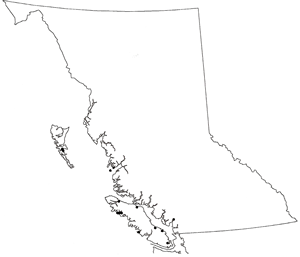This native species is considered an ancient species (Marshall and Fender 2005). McKey-Fender et al. (1994) provide a detailed taxonomic description for Vancouver Island specimens of the species; John Reynolds has summarized this description as follows: “Length 74-88 mm, diameter 4.5-6 mm, segment number 113-121, prostomium epilobic, half open behind, 1st dorsal pore behind clitellum. Clitellum annular, xiii-xviii. Setae separate, AA:AB:BC:CD:DD = 2.6:1.0:2.4:2.2:4.0, DD:U = 0.33 on x, DD:U = 0.41 on xxx. Penial setae strong, curved, sculptured, with rows of teeth, 845 x 26 μ. Male porophores paired, broadly lunate, each with 3 pores (male pore and 2 penisetal pores), covering xviii and encroaching on xvii and xix, centering in B. Genital markings intersegmental, paired or unilateral 19/29, short transverse ovals centered in A. Proventriculus thin-walled, smooth internally. Gizzard mostly in v, 5/6 thin, gizzard short. anterior oesophagus in vii-xiv. Intestine expands in xvii, Typhlosole cross section a narrow-limbed T shape, beginning in xxi and xxii. Posterior calciferous gland region xv and xvi. Caeca paired on dorsum of intestine, deeply saccate in xxiii-xxviii plus lesser sacs in xxix-xxx and bulges in xxxi-xxxiii. Seminal vesciles, postseptal dorsolaterally in xi and xii. Holandric, testes and funnels free in x and xi. Spermathecae, quadrithecal, in vii and ix with broadly ovoid ampulla, spermathecal pores in furrows 7/8 and 8/9. Nephropores inconspicuous. Colour, unpigmented.”
Source: Marshall, Valin G. and William M. Fender. 2007. Native and Introduced Earthworms (Oligochaeta) of British Columbia. Megadrilogica 11 (4): 29-52.
Arctiostrotus perrieri Benham 1892
Earthworm
Family: Acanthodrilidae
Earthworm
Family: Acanthodrilidae
Map

Distribution of Arctiostrotus perrieri in British Columbia.
(Click on the map to view a larger version.)
Source: Marshall and Fender (2007)
Introduction
|
Species Information
Biology
|
Habitat
|
Distribution
|
Status Information
BC Ministry of Environment: BC Species and Ecosystems Explorer--the authoritative source for conservation information in British Columbia. |